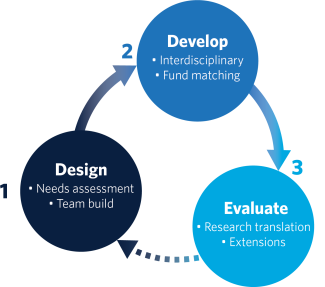Partnering with UBC is designed to be simple, flexible, and scalable, whether you’re seeking a short-term collaboration or a long-term strategic partnership. We believe that no engagement is too small—many of our most impactful partnerships began with a single conversation.
We offer multiple pathways to collaborate:
- Bespoke Research Collaborations – Work with a researcher to solve a specific challenge through a sponsored research agreement.
- Multi-Partner Research Initiatives – Engage with interdisciplinary research teams to tackle broader industry, social or technological challenges.
- Mitacs & Funding-Supported Projects – Leverage government funding to support internships, joint research and innovation initiatives.
Our team can help you identify the right pathway based on your goals, whether it’s accessing UBC’s leading-edge expertise, state-of-the-art facilities or diverse talent pipeline.
Common Model: Sponsored Research
One of the most direct ways to partner with UBC is through a sponsored research project, where industry or government partners bring a specific challenge that aligns with the expertise of a UBC researcher. These partnerships are often focused on a single research field and yield mutually beneficial outcomes.
- We will connect you to UBC experts who align with your needs.
- We can help scope and align your collaboration for mutual benefit and greater impact.
Beyond Sponsored Research: Innovation Discovery Partnerships
For partners looking for a more exploratory or long-term engagement, we offer Innovation Discovery Partnerships. These collaborations:
- Address broader and often interdisciplinary challenges, such as technology applications or complex societal issues.
- Connect you with a network of researchers rather than just a single lab or faculty. Often we run internal Calls for Proposals to invite our over 7000 faculty members to propose solutions to your problems.
- Provide flexibility to adapt research as new opportunities emerge.
Multi-Stage Approach: How We Build Impactful Collaborations
Our flexible three-stage approach guides partnerships from idea to impact.

- Stage 1: DESIGN – Aligning Interests & Defining Scope
We begin by forming a Discovery Team from UBC’s research ecosystem, ensuring a strong alignment between your goals and UBC’s expertise. A steering committee helps guide the process, clarifying shared ambitions and setting the foundation for a successful collaboration.
- Stage 2: DEVELOP – Project Development & Funding Strategy
Once the foundation is set, we bring together researchers from multiple disciplines to collaboratively explore solutions. Our team helps identify opportunities for funding matches, student internships, and other resources to enhance the impact of the research. This stage ensures projects are designed with real-world application in mind.
- Stage 3: EVALUATE – Research Execution & Impact Planning
As research progresses, we track milestones and evaluate success against the original objectives. Outcomes are assessed not only in terms of immediate research goals but also for their potential in commercialization, policy influence or extended collaboration. This stage helps partners explore future opportunities for continued innovation and impact.
